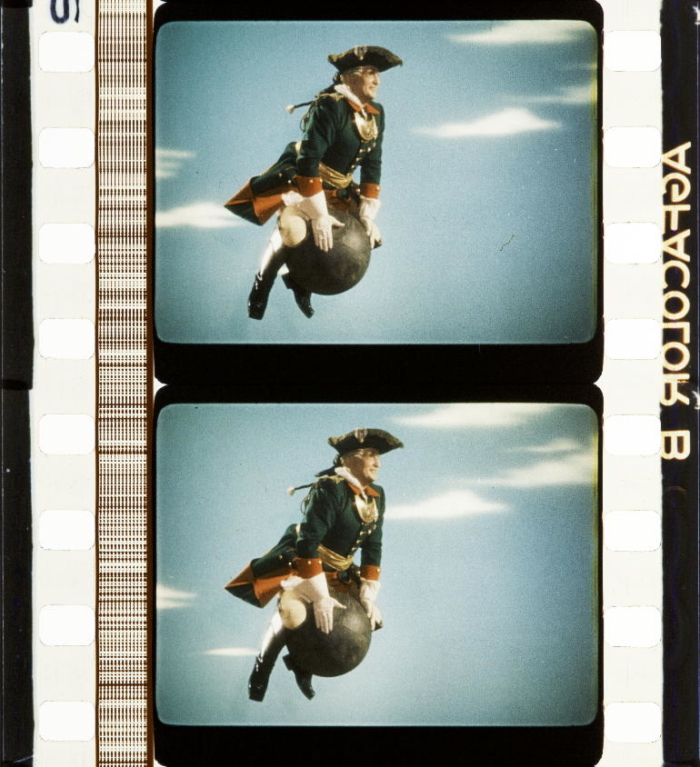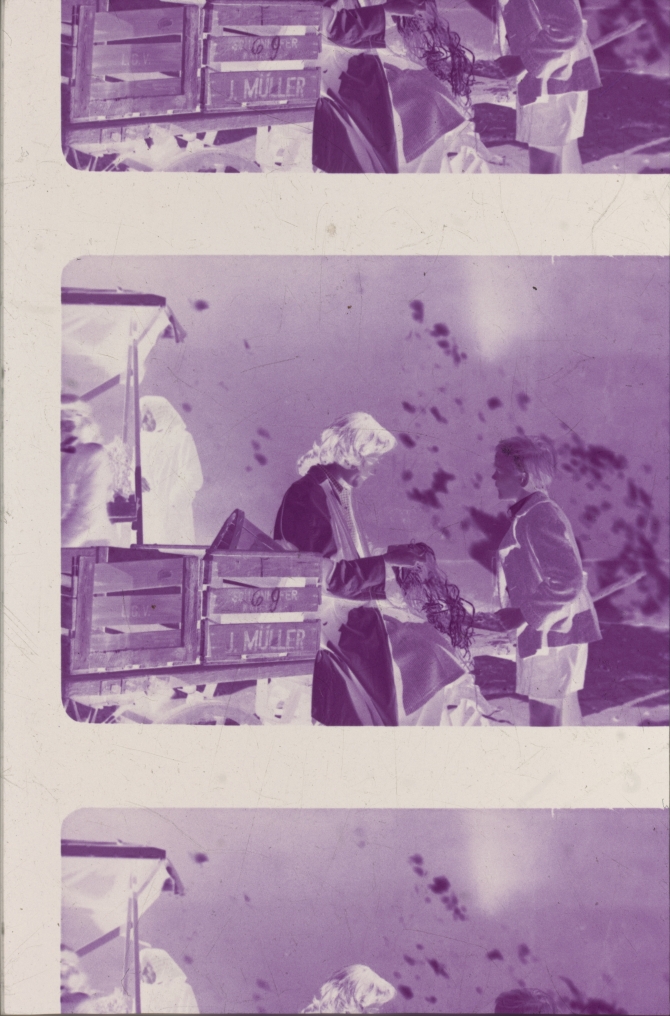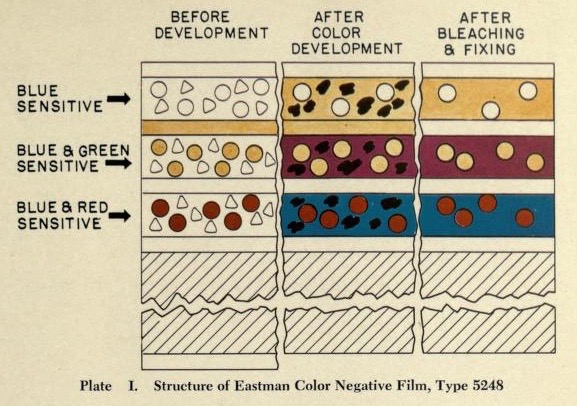- All Categories
- Bibliography
- Chromolytic multilayer
- Color separation
- Double-coated / bi-pack
- Edge Codes and Identification
- Hand coloring
- Other
- Printing / dye-transfer
- Printing / pigment process
- Screen processes
- Spatial synthesis (multiple lenses, beam splitter)
- Stencil coloring (pochoir, Pathécolor)
- Temporal synthesis (rotary filters)
- Theory
- Tinting
- Toning
-
![]() Source: Pénichon, Sylvie (2013): Twentieth Century Colour Photographs. The Complete Guide to Processes, Identification & Preservation. London, Los Angeles: Thames & Hudson, p. 161.
Source: Pénichon, Sylvie (2013): Twentieth Century Colour Photographs. The Complete Guide to Processes, Identification & Preservation. London, Los Angeles: Thames & Hudson, p. 161.
1 Image
“In 1930 Mannes and Godowsky were invited to join the staff of the Kodak Research Laboratory, where they concentrated on methods of processing multilayer films, while their colleagues worked out ways of manufacturing them. The result was the new Kodachrome film, launched in 1935. Three very thin emulsion layers were coated on film base, the emulsions being sensitised with non-wandering dyes to red, green and blue light, the red-sensitive layer being at the bottom.” (Coe, Brian (1978): Colour Photography. The First Hundred Years 1840-1940. London: Ash & Grant, pp. 121 ff.)
-
![]() Credit: Lichtspiel / Kinemathek Bern. Film: New York, Taufe und Ausflug (CH 1954, Donald Brun).
Credit: Lichtspiel / Kinemathek Bern. Film: New York, Taufe und Ausflug (CH 1954, Donald Brun).
- Surface emulsion side, raking light. Credit: Carsta Knaack, HTW Berlin. Film: Regular 8mm home movie, anonymous 1975.
92 Images in 6 Galleries
-
![]() Münchhausen (Josef von Báky, Germany 1943). Credit: Bundesarchiv Filmarchiv and Friedrich-Wilhelm-Murnau-Stiftung. Photographs of the Agfacolor safety print (acetate) by Barbara Flueckiger.
Münchhausen (Josef von Báky, Germany 1943). Credit: Bundesarchiv Filmarchiv and Friedrich-Wilhelm-Murnau-Stiftung. Photographs of the Agfacolor safety print (acetate) by Barbara Flueckiger.
- Opfergang (GER 1944, Veit Harlan), magnification. Credit: Print from the Filmmuseum Düsseldorf. © Friedrich Wilhelm Murnau Foundation, Wiesbaden. Photograph by Barbara Flueckiger.
- Paper print. Source: Serda, Charlott (1941): Das Farbfoto-Buch vom Film. Breitkopf & Härtel: Leipzig.
- Parade (1960). Credit: Harvard Film Archive, Brandon Film Library Collection, item no. 14303. Photographs of Agfacolor negative on Orwocolor reversal print by Barbara Flueckiger.
- Parade (1960). Credit: Harvard Film Archive, Brandon Film Library Collection, item no. 14303. Photographs of Agfacolor negative on Orwocolor reversal print by Barbara Flueckiger.
640 Images in 21 Galleries
-
![]() Agfacolor B original negative. Credit: Národní filmový archiv / National Film Archive, Prague. Film: Jan Roháč z Dubé (Czechoslovakia 1947, Vladimír Borsky).
Agfacolor B original negative. Credit: Národní filmový archiv / National Film Archive, Prague. Film: Jan Roháč z Dubé (Czechoslovakia 1947, Vladimír Borsky).
- Faded Agfacolor period nitrate print. Credit: Národní filmový archiv / National Film Archive, Prague. Film: Jan Roháč z Dubé (Czechoslovakia 1947, Vladimír Borský).
- Agfacolor B original negative. Credit: Národní filmový archiv / National Film Archive, Prague. Film: Jan Roháč z Dubé (Czechoslovakia 1947, Vladimír Borsky).
- Faded Agfacolor period nitrate print. Credit: Národní filmový archiv / National Film Archive, Prague. Film: Jan Roháč z Dubé (Czechoslovakia 1947, Vladimír Borský).
- Agfacolor B original negative. Credit: Národní filmový archiv / National Film Archive, Prague. Film: Jan Roháč z Dubé (Czechoslovakia 1947, Vladimír Borsky).
- Agfacolor B original negative. Credit: Národní filmový archiv / National Film Archive, Prague. Film: Kvítí z Čech (Czechoslovakia 1947, dir. Václav Jan Staněk).
- Agfacolor positive nitrate print. Credit: Národní filmový archiv / National Film Archive, Prague. Film: Kvítí z Čech (Czechoslovakia 1947, dir. Václav Jan Staněk).
- Agfacolor positive nitrate print. Credit: Národní filmový archiv / National Film Archive, Prague. Film: Kvítí z Čech (Czechoslovakia 1947, dir. Václav Jan Staněk).
- Agfacolor B original negative. Credit: Národní filmový archiv / National Film Archive, Prague. Film: Mistr třeboňský (Czechoslovakia 1950, dir. František Kudláč).
- Agfacolor B original negative. Credit: Národní filmový archiv / National Film Archive, Prague. Film: Mistr třeboňský (Czechoslovakia 1950, dir. František Kudláč).
- Agfacolor positive nitrate print. Credit: Národní filmový archiv / National Film Archive, Prague. Film: Mistr třeboňský (Czechoslovakia 1950, dir. František Kudláč).
- Agfacolor B original negative. Credit: Národní filmový archiv / National Film Archive, Prague. Film: Praha v říjnu (Czechoslovakia 1945, dir. František Sádek).
- Faded Agfacolor period nitrate print. Credit: Národní filmový archiv / National Film Archive, Prague. Film: Praha v říjnu (Czechoslovakia 1945, dir. František Sádek).
- Agfacolor B original negative. Credit: Národní filmový archiv / National Film Archive, Prague. Film: Praha v říjnu (Czechoslovakia 1945, dir. František Sádek).
- Agfacolor B original negative. Credit: Národní filmový archiv / National Film Archive, Prague. Film: Zasadil dědek řepu (Czechoslovakia 1945, dir. Jiří Trnka).
- Agfacolor positive nitrate print. Credit: Národní filmový archiv / National Film Archive, Prague. Film: Zasadil dědek řepu (Czechoslovakia 1945, Jiří Trnka).
- Agfacolor positive nitrate print. Credit: Národní filmový archiv / National Film Archive, Prague. Film: Zasadil dědek řepu (Czechoslovakia 1945, Jiří Trnka).
- Credit: By courtesy of Deutsche Kinemathek, Berlin. Photograph by Barbara Flueckiger. Film: 1/50 Sekunde, commercial for Niggemeyer Foto/Kino (1952).
- Schmidt, Richard / Kochs, Adolf (1943): Farbfilmtechnik. Eine Einführung für Filmschaffende. Berlin: Hesse, pp. 77-98. (Schriftenreihe der Reichsfilmkammer, 10.) (in German) [quote cite='35875']
- Schmidt, Richard / Kochs, Adolf (1943): Farbfilmtechnik. Eine Einführung für Filmschaffende. Berlin: Hesse, pp. 77-98. (Schriftenreihe der Reichsfilmkammer, 10.) (in German) [quote cite='35875']
- Schmidt, Richard / Kochs, Adolf (1943): Farbfilmtechnik. Eine Einführung für Filmschaffende. Berlin: Hesse, pp. 77-98. (Schriftenreihe der Reichsfilmkammer, 10.) (in German) [quote cite='35875']
21 Images
Agfacolor Negative type G was a chromogenic camera negative balanced for Tungsten illumination.
-
![]() Original Agfacolor negative G. Credit: Národní filmový archiv / National Film Archive, Prague. Film: Neposlušný zajíček (German title Klein, aber Oho!, Horst von Möllendorff, Czechoslovakia 1944).
Original Agfacolor negative G. Credit: Národní filmový archiv / National Film Archive, Prague. Film: Neposlušný zajíček (German title Klein, aber Oho!, Horst von Möllendorff, Czechoslovakia 1944).
- Schmidt, Richard / Kochs, Adolf (1943): Farbfilmtechnik. Eine Einführung für Filmschaffende. Berlin: Hesse, pp. 77-98. (Schriftenreihe der Reichsfilmkammer, 10.) (in German) [quote cite='35875']
- Schmidt, Richard / Kochs, Adolf (1943): Farbfilmtechnik. Eine Einführung für Filmschaffende. Berlin: Hesse, pp. 77-98. (Schriftenreihe der Reichsfilmkammer, 10.) (in German) [quote cite='35875']
14 Images in 2 Galleries
-
![]() Agfacolor B negative on Agfacolor positive. Credit: Národní filmový archiv / National Film Archive, Prague. Film: Tábor (Oldřich Mirad, Czechoslovakia 1953). Photograph by Barbara Flueckiger.
Agfacolor B negative on Agfacolor positive. Credit: Národní filmový archiv / National Film Archive, Prague. Film: Tábor (Oldřich Mirad, Czechoslovakia 1953). Photograph by Barbara Flueckiger.
37 Images in 2 Galleries
-
![]() Skleněné varhany (Stěklanna je garmonika, Andrej Chržanovskij, USSR 1968). Credit: Národní filmový archiv / National Film Archive, Prague. Photograph by Barbara Flueckiger
Skleněné varhany (Stěklanna je garmonika, Andrej Chržanovskij, USSR 1968). Credit: Národní filmový archiv / National Film Archive, Prague. Photograph by Barbara Flueckiger
15 Images in 3 Galleries
“The Konicolor system, introduced by Konishiroku Shashin Kogyo (Now Konica Minolta Holdings, Inc.), split the image into three colors and shot them separately onto three b&w films. In that sense it had something in common with the US ‘Technicolor system’, but this was not a contact print with color dye to create positive film, but used coated emulsion to develop each color in a triple process, which is peculiar. […].”
-
![]() Credit: Illustration by Sarah Steinbacher, Multimedia & E-Learning-Services, University of Zurich. Source: Ryan, Roderick T. (1977): A History of Motion Picture Color Technology. London: Focal Press.
Credit: Illustration by Sarah Steinbacher, Multimedia & E-Learning-Services, University of Zurich. Source: Ryan, Roderick T. (1977): A History of Motion Picture Color Technology. London: Focal Press.
- Source: Ryan, Roderick T. (1977): A History of Motion Picture Color Technology. London: Focal Press.
- Source: Sease, V. B. (1949): DuPont's New Color Film. In:American Cinematographer, 30: 240, 257-258.
- Credit: Illustration by Sarah Steinbacher, Multimedia & E-Learning-Services, University of Zurich. Source: Sease, V. B. (1949): DuPont's New Color Film. In:American Cinematographer, 30: 240, 257-258.
8 Images in 1 Gallery
-
![]() Don't Look Now (GBR / ITA 1973, Nicolas Roeg). Credit: BFI National Film Archive. Photographs of the faded Fujicolor HP Positive Film Type 8813 by Joëlle Kost, ERC Advanced Grant FilmColors.
Don't Look Now (GBR / ITA 1973, Nicolas Roeg). Credit: BFI National Film Archive. Photographs of the faded Fujicolor HP Positive Film Type 8813 by Joëlle Kost, ERC Advanced Grant FilmColors.
141 Images in 7 Galleries
-
![]() Faded Ferraniacolor positive from Eastmancolor negative, anamorphic (1:2,35). Credit: Národní filmový archiv / National Film Archive, Prague. Film: Smrt v sedle (Jindřich Polák, Czechoslovakia 1958).
Faded Ferraniacolor positive from Eastmancolor negative, anamorphic (1:2,35). Credit: Národní filmový archiv / National Film Archive, Prague. Film: Smrt v sedle (Jindřich Polák, Czechoslovakia 1958).
- Faded Ferraniacolor positive from Eastmancolor negative, anamorphic (1:2,35). Credit: Národní filmový archiv / National Film Archive, Prague. Film: Smrt v sedle (Jindřich Polák, Czechoslovakia 1958).
- Faded Ferraniacolor positive from Eastmancolor negative, anamorphic (1:2,35). Credit: Národní filmový archiv / National Film Archive, Prague. Film: Smrt v sedle (Jindřich Polák, Czechoslovakia 1958).
- Faded Ferraniacolor positive from Eastmancolor negative, anamorphic (1:2,35). Credit: Národní filmový archiv / National Film Archive, Prague. Film: Smrt v sedle (Jindřich Polák, Czechoslovakia 1958).
- Faded Ferraniacolor positive from Eastmancolor negative, anamorphic (1:2,35). Credit: Národní filmový archiv / National Film Archive, Prague. Film: Smrt v sedle (Jindřich Polák, Czechoslovakia 1958).
- Faded Ferraniacolor positive from Eastmancolor negative, anamorphic (1:2,35). Credit: Národní filmový archiv / National Film Archive, Prague. Film: Smrt v sedle (Jindřich Polák, Czechoslovakia 1958).
- Faded Ferraniacolor positive from Eastmancolor negative, anamorphic (1:2,35). Credit: Národní filmový archiv / National Film Archive, Prague. Film: Smrt v sedle (Jindřich Polák, Czechoslovakia 1958).
217 Images in 8 Galleries
-
![]() Alien (USA 1979, Ridley Scott). Credit: Library of Congress. Photographs of the Eastman Color Print Film from 1979 by Joëlle Kost, ERC Advanced Grant FilmColors.
Alien (USA 1979, Ridley Scott). Credit: Library of Congress. Photographs of the Eastman Color Print Film from 1979 by Joëlle Kost, ERC Advanced Grant FilmColors.
- Photomicrograph of modern chromogenic stock, . Credit: Silvana Konermann.
- Eastman Color chromogenic monopack. Source: Craig, G.J. (1953): Eastman Colour Films for Professional Motion Picture Work. In: British Kinematography, 22,5, 1953, pp. 146-158.
- Color fading of Eastmancolor stock. Credit: Collection Gert Koshofer, Bergisch Gladbach (Germany). Source: Schultze, Werner (1953): Farbenphotographie und Farbenfilm. Wissenschaftliche Grundlagen und technische Gestaltung. Berlin: Springer.
- Color reconstruction by Rudolf Gschwind, University of Basel. Credit: Collection Gert Koshofer, Bergisch Gladbach (Germany).
- Color fading of Eastmancolor stock.
- Source: Schultze, Werner (1953): Farbenphotographie und Farbenfilm. Wissenschaftliche Grundlagen und technische Gestaltung. Berlin/Göttingen /Heidelberg: Springer-Verlag. Photograph by Martin Weiss, ERC Advanced Grant FilmColors.
- Source: Schultze, Werner (1953): Farbenphotographie und Farbenfilm. Wissenschaftliche Grundlagen und technische Gestaltung. Berlin/Göttingen /Heidelberg: Springer-Verlag. Photograph by Martin Weiss, ERC Advanced Grant FilmColors.
707 Images in 23 Galleries
-
![]() Ansco Color, positives of Ansco Color negative, ca. 1952. Credit: Gert Koshofer Collection. Sample No. 10. Photograph by Barbara Flueckiger.
Ansco Color, positives of Ansco Color negative, ca. 1952. Credit: Gert Koshofer Collection. Sample No. 10. Photograph by Barbara Flueckiger.
- Source: Schultze, Werner (1953): Farbenphotographie und Farbenfilm. Wissenschaftliche Grundlagen und technische Gestaltung. Berlin/Göttingen /Heidelberg: Springer.
- Source: Schultze, Werner (1953): Farbenphotographie und Farbenfilm. Wissenschaftliche Grundlagen und technische Gestaltung. Berlin/Göttingen /Heidelberg: Springer.
- Source: Society of Motion Picture and Television Engineers; ed. (1957): The Elements of Color in Professional Motion Pictures. Prepared by a special committee of the Society. Wilton R. Holm, chairman. New York: The Society.
- Credit: Cinémathèque française, conservatoire des techniques, Paris.
- Source: Schultze, Werner (1953): Farbenphotographie und Farbenfilm. Wissenschaftliche Grundlagen und technische Gestaltung. Berlin/Göttingen /Heidelberg: Springer-Verlag. Photograph by Martin Weiss, ERC Advanced Grant FilmColors.
- Source: Schultze, Werner (1953): Farbenphotographie und Farbenfilm. Wissenschaftliche Grundlagen und technische Gestaltung. Berlin/Göttingen /Heidelberg: Springer-Verlag. Photograph by Martin Weiss, ERC Advanced Grant FilmColors.
30 Images in 2 Galleries
-
![]() Credit: By courtesy of Deutsche Kinemathek, Berlin. Photograph by Barbara Flueckiger. Film: Commercial Denkt rechtzeitig daran (GER 1952).
Credit: By courtesy of Deutsche Kinemathek, Berlin. Photograph by Barbara Flueckiger. Film: Commercial Denkt rechtzeitig daran (GER 1952).
- Credit: By courtesy of Deutsche Kinemathek, Berlin. Photograph by Barbara Flueckiger. Film: 1/50 Sekunde, commercial for Niggemeyer Foto/Kino (1952).
13 Images in 2 Galleries
-
![]() Cross section scheme of Eastman Color Type 5248. Scource: Hanson, W. T., Jr.; Kisner, W. I. (1953): Improved Color Films for Color Motion-Picture Production. In: Journal SMPTE, Vol. 61, Dec. 1953, p. 699.
Cross section scheme of Eastman Color Type 5248. Scource: Hanson, W. T., Jr.; Kisner, W. I. (1953): Improved Color Films for Color Motion-Picture Production. In: Journal SMPTE, Vol. 61, Dec. 1953, p. 699.
1 Image
-
![]() Negative. Credit: Národní filmový archiv / National Film Archive, Prague. Film: Princezna se zlatou hvězdou (Martin Frič, Czechoslovakia 1959).
Negative. Credit: Národní filmový archiv / National Film Archive, Prague. Film: Princezna se zlatou hvězdou (Martin Frič, Czechoslovakia 1959).
- Negative. Credit: Národní filmový archiv / National Film Archive, Prague. Film: Princezna se zlatou hvězdou (Martin Frič, Czechoslovakia 1959).
- Negative. Credit: Národní filmový archiv / National Film Archive, Prague. Film: Princezna se zlatou hvězdou (Martin Frič, Czechoslovakia 1959).
- Negative. Credit: Národní filmový archiv / National Film Archive, Prague. Film: Princezna se zlatou hvězdou (Martin Frič, Czechoslovakia 1959).
- Princezna se zlatou hvězdou (CZE 1959, Martin Frič). Credit: Národní filmový archiv / National Film Archive, Prague. Photographs of the Agfacolor B negative on Orwocolor positive by Barbara Flueckiger.
- Princezna se zlatou hvězdou (CZE 1959, Martin Frič). Credit: Národní filmový archiv / National Film Archive, Prague. Photographs of the Agfacolor B negative on Orwocolor positive by Barbara Flueckiger.
- Princezna se zlatou hvězdou (CZE 1959, Martin Frič). Credit: Národní filmový archiv / National Film Archive, Prague. Photographs of the Agfacolor B negative on Orwocolor positive by Barbara Flueckiger.
- Princezna se zlatou hvězdou (CZE 1959, Martin Frič). Credit: Národní filmový archiv / National Film Archive, Prague. Photographs of the Agfacolor B negative on Orwocolor positive by Barbara Flueckiger.
- Princezna se zlatou hvězdou (CZE 1959, Martin Frič). Credit: Národní filmový archiv / National Film Archive, Prague. Photographs of the Agfacolor B negative on Orwocolor positive by Barbara Flueckiger.
- Princezna se zlatou hvězdou (CZE 1959, Martin Frič). Credit: Národní filmový archiv / National Film Archive, Prague. Photographs of the Agfacolor B negative on Orwocolor positive by Barbara Flueckiger.
- Princezna se zlatou hvězdou (CZE 1959, Martin Frič). Credit: Národní filmový archiv / National Film Archive, Prague. Photographs of the Agfacolor B negative on Orwocolor positive by Barbara Flueckiger.
11 Images
-
![]() Cross section scheme, Agfacolor Positive Type 5. Scource: Brune, Wolfgang (1955): Ein neues Agfacolor-Positivmaterial (Agfacolor-Positivfilm Typ 5).
Cross section scheme, Agfacolor Positive Type 5. Scource: Brune, Wolfgang (1955): Ein neues Agfacolor-Positivmaterial (Agfacolor-Positivfilm Typ 5).


















